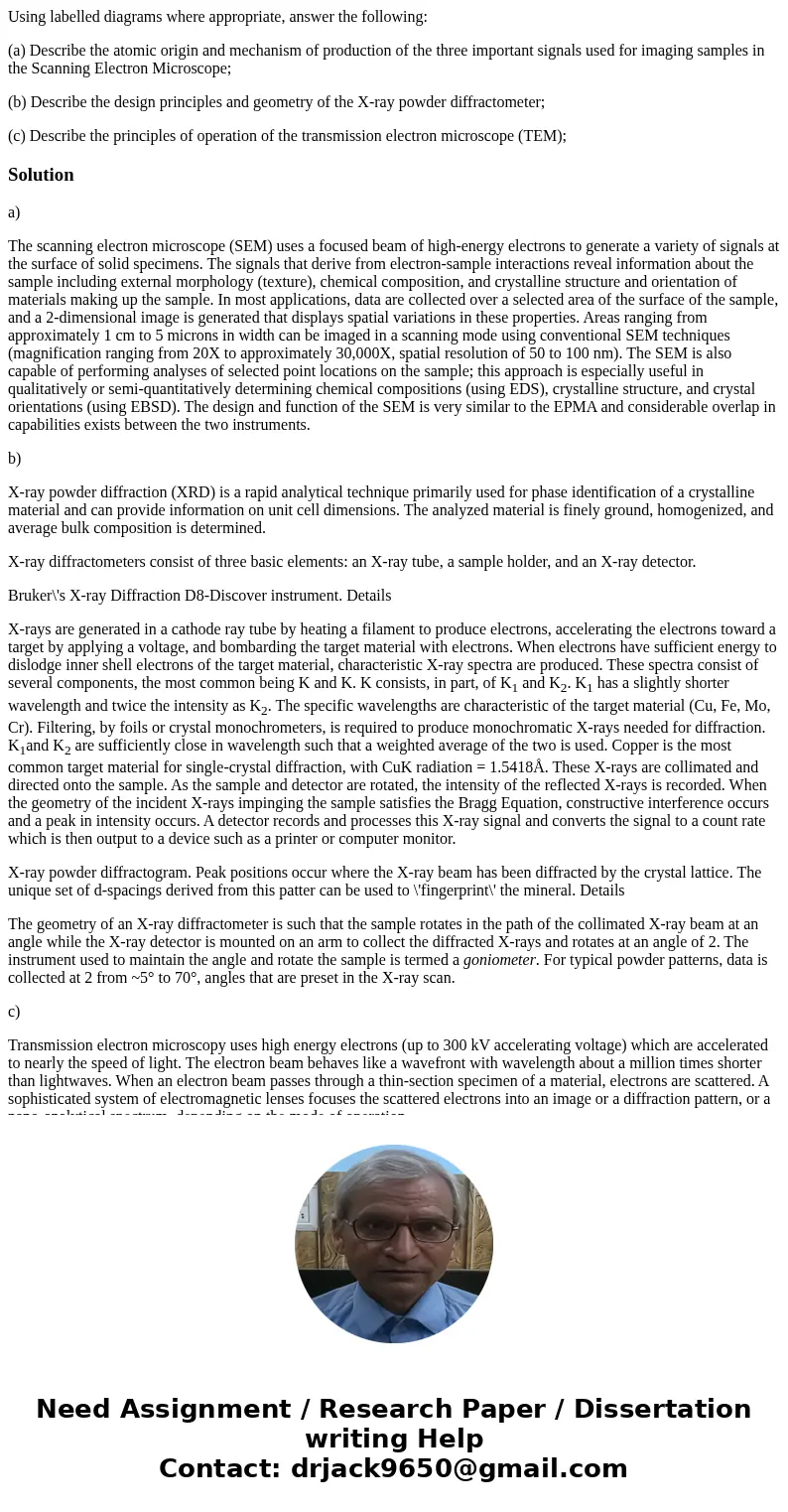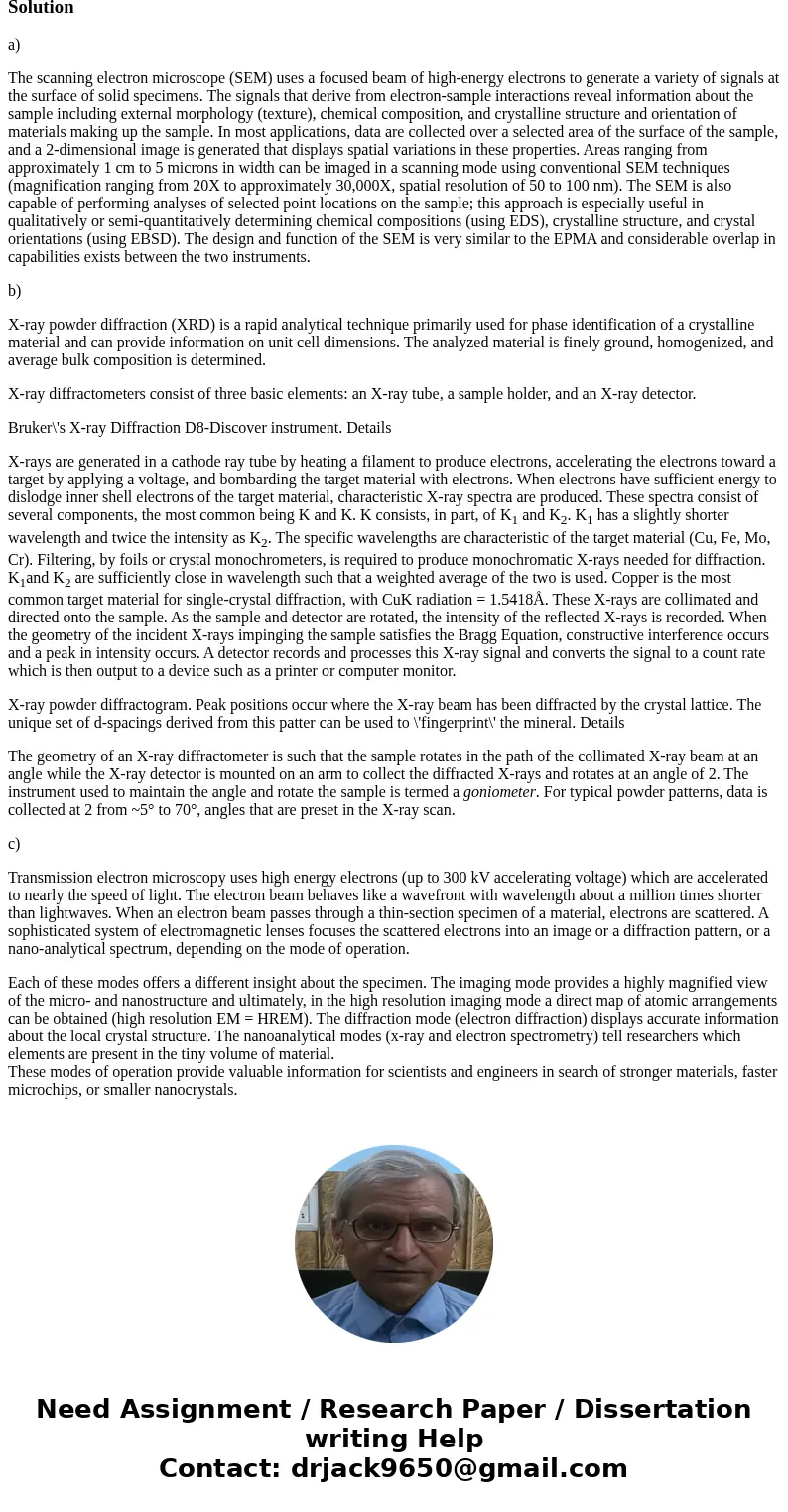Using labelled diagrams where appropriate answer the followi
Using labelled diagrams where appropriate, answer the following:
(a) Describe the atomic origin and mechanism of production of the three important signals used for imaging samples in the Scanning Electron Microscope;
(b) Describe the design principles and geometry of the X-ray powder diffractometer;
(c) Describe the principles of operation of the transmission electron microscope (TEM);
Solution
a)
The scanning electron microscope (SEM) uses a focused beam of high-energy electrons to generate a variety of signals at the surface of solid specimens. The signals that derive from electron-sample interactions reveal information about the sample including external morphology (texture), chemical composition, and crystalline structure and orientation of materials making up the sample. In most applications, data are collected over a selected area of the surface of the sample, and a 2-dimensional image is generated that displays spatial variations in these properties. Areas ranging from approximately 1 cm to 5 microns in width can be imaged in a scanning mode using conventional SEM techniques (magnification ranging from 20X to approximately 30,000X, spatial resolution of 50 to 100 nm). The SEM is also capable of performing analyses of selected point locations on the sample; this approach is especially useful in qualitatively or semi-quantitatively determining chemical compositions (using EDS), crystalline structure, and crystal orientations (using EBSD). The design and function of the SEM is very similar to the EPMA and considerable overlap in capabilities exists between the two instruments.
b)
X-ray powder diffraction (XRD) is a rapid analytical technique primarily used for phase identification of a crystalline material and can provide information on unit cell dimensions. The analyzed material is finely ground, homogenized, and average bulk composition is determined.
X-ray diffractometers consist of three basic elements: an X-ray tube, a sample holder, and an X-ray detector.
Bruker\'s X-ray Diffraction D8-Discover instrument. Details
X-rays are generated in a cathode ray tube by heating a filament to produce electrons, accelerating the electrons toward a target by applying a voltage, and bombarding the target material with electrons. When electrons have sufficient energy to dislodge inner shell electrons of the target material, characteristic X-ray spectra are produced. These spectra consist of several components, the most common being K and K. K consists, in part, of K1 and K2. K1 has a slightly shorter wavelength and twice the intensity as K2. The specific wavelengths are characteristic of the target material (Cu, Fe, Mo, Cr). Filtering, by foils or crystal monochrometers, is required to produce monochromatic X-rays needed for diffraction. K1and K2 are sufficiently close in wavelength such that a weighted average of the two is used. Copper is the most common target material for single-crystal diffraction, with CuK radiation = 1.5418Å. These X-rays are collimated and directed onto the sample. As the sample and detector are rotated, the intensity of the reflected X-rays is recorded. When the geometry of the incident X-rays impinging the sample satisfies the Bragg Equation, constructive interference occurs and a peak in intensity occurs. A detector records and processes this X-ray signal and converts the signal to a count rate which is then output to a device such as a printer or computer monitor.
X-ray powder diffractogram. Peak positions occur where the X-ray beam has been diffracted by the crystal lattice. The unique set of d-spacings derived from this patter can be used to \'fingerprint\' the mineral. Details
The geometry of an X-ray diffractometer is such that the sample rotates in the path of the collimated X-ray beam at an angle while the X-ray detector is mounted on an arm to collect the diffracted X-rays and rotates at an angle of 2. The instrument used to maintain the angle and rotate the sample is termed a goniometer. For typical powder patterns, data is collected at 2 from ~5° to 70°, angles that are preset in the X-ray scan.
c)
Transmission electron microscopy uses high energy electrons (up to 300 kV accelerating voltage) which are accelerated to nearly the speed of light. The electron beam behaves like a wavefront with wavelength about a million times shorter than lightwaves. When an electron beam passes through a thin-section specimen of a material, electrons are scattered. A sophisticated system of electromagnetic lenses focuses the scattered electrons into an image or a diffraction pattern, or a nano-analytical spectrum, depending on the mode of operation.
Each of these modes offers a different insight about the specimen. The imaging mode provides a highly magnified view of the micro- and nanostructure and ultimately, in the high resolution imaging mode a direct map of atomic arrangements can be obtained (high resolution EM = HREM). The diffraction mode (electron diffraction) displays accurate information about the local crystal structure. The nanoanalytical modes (x-ray and electron spectrometry) tell researchers which elements are present in the tiny volume of material.
These modes of operation provide valuable information for scientists and engineers in search of stronger materials, faster microchips, or smaller nanocrystals.


 Homework Sourse
Homework Sourse